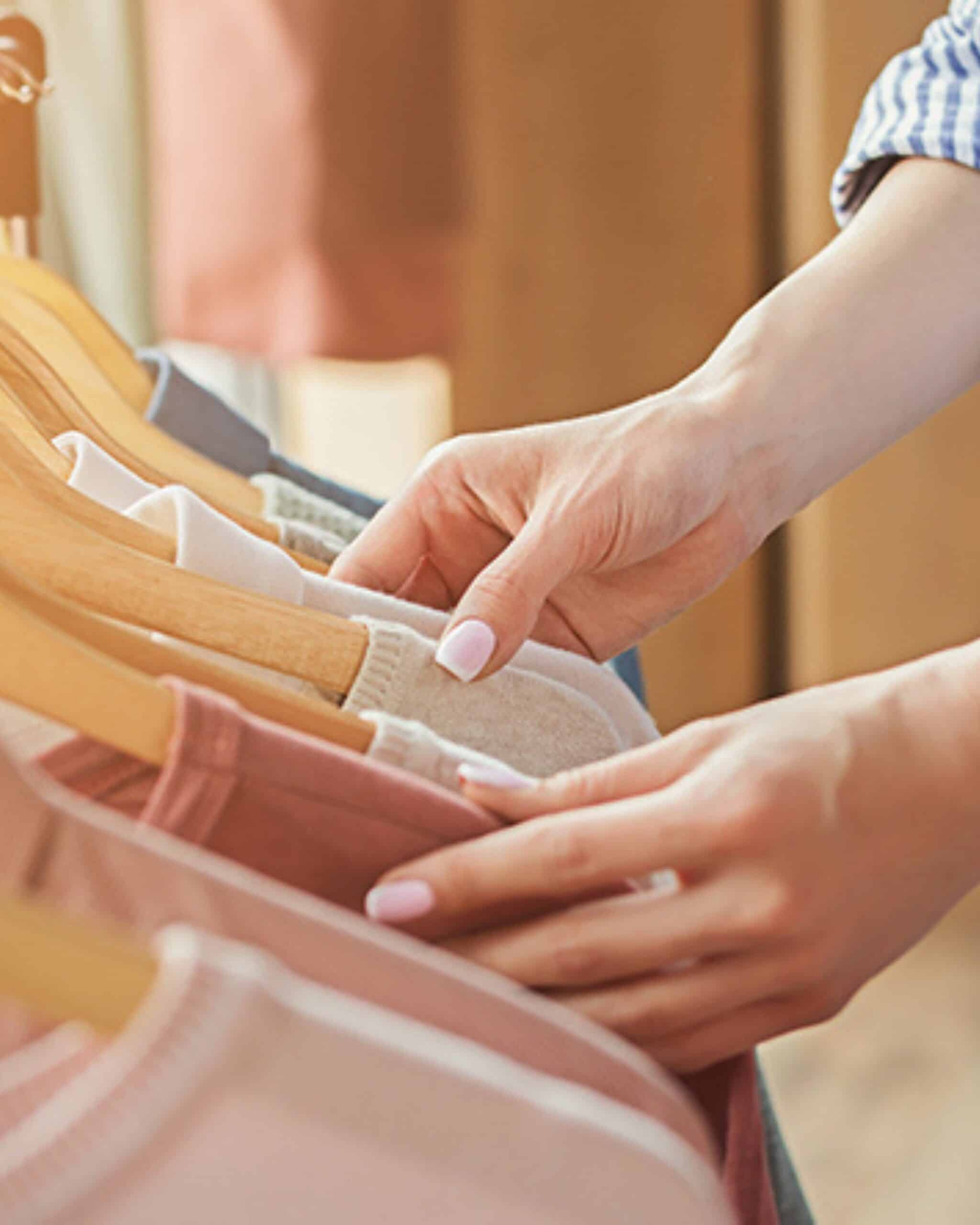Hiya Gorgeous,
I love this transitional period between spring and summer. For those of us who live in areas of the world with seasonal shifts like this, it’s time to pack up winter clothes and bust out the warm weather gear. T-shirts replace sweaters, sunglasses sub in for scarves, flip flops take over for boots…
It can be a lot of fun to rediscover the stuff that’s been packed away for months and even add a few new things to our closets. But there’s a dark side to these seasonal wardrobe shifts—the pressure to buy, buy, buy.
Now don’t get me wrong, I think that fashion can be a fun way to express ourselves. But when you combine insatiable demand for trends with the fast-paced nature of today’s world and ruthless competition to create the cheapest products possible, fast fashion is born.
Today we’re going to cover what fast fashion is, why it’s a problem (especially for the environment) and what you can do to help. I’ll provide you with some specific, simple tips—it’s not complicated or hard, I promise!
What is fast fashion, anyway?
The term “fast fashion” is used to describe trendy clothing that’s mass-produced to meet consumer demands (note: I use the word “clothing” throughout this article for simplicity’s sake, but I’m talking about all fashion, which means shoes, bags, accessories, etc.). These items are usually made inexpensively and rapidly in an effort to cut costs and deliver products to the market as fast as possible.
Many people associate fast fashion with cheap, throw-away crap that lasts about as long in your closet as an avocado does on your counter. This kind of clothing often falls apart after a couple of washes or wears due to low quality standards. It also tends to go out of style quickly because it’s made to meet society’s hunger for passing trends, not to stand the test of time.
Wondering how to figure out what’s fast fashion and what’s not? It’s not always cut and dry, and it’s important to research your favorite brands. But keep an eye out for clothing that’s priced really low—there’s usually a reason it’s so cheap, and someone somewhere might be paying the price. Also tread carefully when shopping from the stores you’d typically find in malls or those owned by big corporations. I’m not saying they’re all bad, but I encourage you to look into their environmental and labor standards. I’ll share some resources later on in this post to help you learn what to look out for and how to research your go-to brands.
Why is fast fashion a problem?
As with many mass-produced consumer goods (everything from your couch to the utensils you use in your kitchen), the problems with fast fashion are far-reaching and incredibly complex. I know it can be hard to wrap your head around these issues, so I’ve broken down some of the key themes and impacts below.
While we can’t cover all of the nuances and details surrounding this issue in one article, understanding these aspects is a good place to start.
The Environment
Society’s hunger for fast, cheap, trendy fashion hurts our planet in a number of serious ways. Here are some of the biggest environmental impacts:
- Water consumption: It takes about 2,700 liters of water to make just one cotton shirt (source). And those shirts (and jeans and dresses and purses and so on!) add up quickly. According to the World Resources Institute, that’s enough water for one person to drink for 2 ½ years. Another study estimated that the global fashion industry consumes enough water every year to fill 32 million Olympic-size swimming pools (source).
- Pollution: The fashion industry is responsible for about 20% of water pollution around the globe. It’s also to blame for about 5% of global greenhouse gas emissions (source). That’s right… for the entire world. Plus, one study found that approximately 30% of the substances used to make clothing pose a risk to human health (source).
- Waste and landfills: Because fast fashion products either wear or go out of style quickly, we’re throwing a whole lot away. A 2016 article from McKinsey states that within a year of being produced, almost three-fifths of all clothing ends up in incinerators or landfills. That means those potentially harmful, non-biodegradable materials we discussed just sit there slowly seeping toxins into the air, ground and water.
People
While consumer pressure has caused some fast fashion brands to improve conditions in their factories, many workers are still subject to unsafe work environments. In 2018, the U.S. Department of Labor reported evidence of forced and child labor in the fashion industry in several countries (source).
Young women between the ages of 18 and 24 make about 80% of the apparel on the market. And they’re often not paid a living wage because fast fashion companies hoard most of the profits for themselves. They’re forced to live in poverty, often unable to afford the bare minimum necessities for their families (source).
Animals
People aren’t the only living beings impacted by fast fashion. Our furry and feathered friends are vulnerable, too. For example, most of the world’s leather comes from India and China, where animal welfare legislation doesn’t exist. And in the countries where those laws do exist, the legal protections are geared toward pets and often don’t extend to animals raised for leather. Make no mistake, leather is not simply a by-product of the meat industry (which is deeply problematic in and of itself!).
And as for that wool sweater—well, we’re not talking about happy sheep who get to live stress-free lives running free and playing with their friends. Many of the sheep exploited for their wool undergo painful procedures and live in otherwise inhumane conditions. More responsibly sourced wool does exist, but it’s more expensive and hard to come by from the big fashion retailers (source).
The bottom line when it comes to animal products used for clothing: If it doesn’t say it’s ethically produced, it’s probably not. And many people (myself included!) believe that regardless of the process, owning and using living creatures like commodities is exploitation, plain and simple.
Our Mindset
The fast fashion industry isn’t just polluting our planet, it’s also polluting our minds. We’re constantly flooded with ads designed to make us think that buying = happiness. There’s unbelievable pressure to follow the latest trends and never wear the same thing twice. And while fashion can be a fun and beautiful way to express our individuality, it can also make us feel inadequate or bad about ourselves.
The messages are pretty clear: We’ll be more attractive/successful/desirable/satisfied/etc. when we buy. But the more we buy, the more we end up throwing away (that shirt is so last year, am I right?!). That kind of mindset is really at the root of the fast fashion problem: The industry has to cut corners to keep up with voracious demand. The more we demand, the more they produce. And the more they get away with producing and selling, the harder they push us to consume even more.
7 Simple Ways to Stop Supporting Fast Fashion
This may be a complicated issue, but together we can influence big change. Even one small shift in the way you approach your wardrobe has the power to make a difference. Start by trying one of these tips on for size.
1. Remember that less is more.
I remember when my cousin (a well-known photo director in the fashion industry) saw my closet for the first time. I had a good chuckle when she praised me for doing a great job on my “spring closet edit.” My response: That’s no edit, that’s everything I own! LOL. Now, I haven’t mastered this, but I’m working on cultivating a mindful, minimal approach to my wardrobe—something I’m hoping you’ll be inspired to do, too.
Contrary to what the big fast fashion retailers want you to think, true style is not about having a closet that’s overflowing with all of the latest passing fads. Rather than jumping on every trend train (because they never stop coming—so why stress yourself out trying to keep up?!), choose fewer high-quality, classic, versatile pieces. They’ll last longer and you can say buh-bye to that whole “I can’t see my floor because it’s covered in a mountain of clothes but I still have nothing to wear” feeling.
2. Focus on the stuff you love.
Style is about expressing your individuality and being comfortable. It’s about feeling your best and dressing in a way that allows your gorgeous light to shine through. When you focus on wearing what you love rather than what the ads/models/media tell you to wear, you’ll find that you naturally start buying less. You’ll gravitate toward the stuff that really sparks joy (thanks Marie Kondo!) and stop filling your space with stuff you only wear once… or never.
3. Get educated.
There are tons of incredible resources out there to help you learn more about the problems with fast fashion and what you can do to influence change. Here are just a few:
- Eco Warrior Princess publishes tons of helpful articles on all things sustainability. They’ve dedicated a whole section of the site to fashion, where you’ll find practical, well-researched articles to help you understand these issues. The Good Trade is another fantastic website in this same vein that I recommend checking out!
- Good On You’s mission statement says it all: “Wear the change you want to see.” This website and app is run by a group of campaigners, fashion pros, scientists, writers and developers who aim to help create a world where fashion is sustainable and fair. They rate fashion brands based on criteria such as environmental impact, labor conditions and animal welfare. DoneGood is another great app that’s designed to help you find environmentally and socially responsible brands.
- The Minimalists Podcast is what it sounds like… a podcast about minimalism! You don’t have to go full-blown minimalist to pick up some great ideas from these guys. Listening is a great way to get into that “less is more” mindset we discussed above. Plus, they have a whole episode (#56) on clothing.
- On my watch/read list: The True Cost (this documentary is available on Netflix!) and The Travels of a T-Shirt in the Global Economy.
And while you’re at it, don’t forget to share the love! When you learn something interesting—especially something that inspires you to take action—get your peeps in on it, too. Saving the planet is more fun together, after all. Just remember to lead with compassion, patience and understanding. People tend not to respond to negativity, preachiness, etc., so opt for positivity and your unique brand of amazingness (the world needs it, toots!). We can influence so much more change that way.
4. Practice conscious consumption.
Let me be perfectly clear—our conversation today is not about buying more! Reducing overall demand is a big part of stopping fast fashion. As we’ve discussed, that means adopting a more minimalist approach to your wardrobe.
If you do feel compelled to buy something new, think carefully about whether or not you really need it. And if you don’t really need it—do you just want it? That’s ok, too! There’s nothing wrong with treating yourself or filling the gaps in your closet. Just choose wisely. Again, it all comes down to being mindful about when and how we buy.
5. Support more sustainable clothing brands.
So if you’re gonna buy stuff, what should you buy? There are lots of ethical, sustainable clothing brands out there doing incredible work to put an end to fast fashion. They’re changing the types of materials we use and how we source them. They’re treating workers with the respect they deserve, paying them fairly, and elevating minorities, women and people of color. Some companies are even rethinking the entire fashion process from conception to closet.
So whaddya say we celebrate those brands, eh? There’s something sustainable for everyone—luxurious high-end pieces, comfy basics and everything in between. Here are just a few of the brands I love:
- Everlane
- Reformation
- PACT
- Angela Roi
- Mara Hoffman
- Girlfriend Collective
- Eileen Fisher
- Patagonia
- Stella McCartney
Note: Some of these brands aren’t completely vegan, so I encourage you to check out the materials before you buy. That kind of due diligence is a good idea for any purchase!
And some of the bigger brands are making efforts to reduce their environmental footprint through sustainability initiatives (like Levi’s WaterLess collection, for example). I try to support smaller brands when possible, but sometimes they’re expensive or hard to find. Let’s acknowledge the efforts of these more established companies so they keep it up!
6. Embrace second-hand.
You know how the old saying goes: Your trash is someone else’s treasure! And that piece of clothing that someone else is sick of could be your new favorite thing to wear. There are so many ways to shop/give second-hand. Do clothing swaps with your friends. Go to thrift stores or thrift online—sites like ThredUp, The Real Real and Poshmark are changing the second-hand game. Yes, these sites will have clothing from fast fashion retailers, but giving that stuff a second life does reduce its impact.
Have an event coming up and need something fancy to wear? Try renting your outfit rather than buying something you’ll only use once! Using a service like Rent the Runway is a great way to do that. And don’t forget to donate the stuff that’s no longer serving you so it doesn’t take up space in your closet. Bottom line: Think before you throw away. The more use we can get out of clothes, the better.
7. Acknowledge your privilege.
This one isn’t easy, but it’s important. It is a privilege to have the time/money/resources/headspace/etc. to carefully consider an issue like fast fashion and how we can make change. Many people all over the world do not have that same privilege.
Sustainable fashion is often prohibitively expensive (though some of the brands I mentioned above do provide more affordable options). Folks who are worried about putting food on the table or being able to pay off their medical bills can’t necessarily afford a pair of sustainably sourced, ethically made jeans. And those surrounded by conflict, upheaval, prejudice, etc. might not have the headspace or energy to consider these issues.
This isn’t a problem we can solve today. But we can acknowledge it and be aware of how it might impact our perspective. And we can take on some extra responsibility on behalf of the folks who can’t right now. Remember what I said about us being in this together?
As we think about the small changes we can make to help protect our environment from threats like fast fashion, I want to encourage you to be gentle with yourself. Living a more sustainable life is not an end goal, it’s an ever-evolving process.
Choose to focus on what you can do, not what you can’t. Honor your efforts and appreciate what you learn from your missteps. For example, I’m doing my best to also apply this info to the photo and video shoots we do for KrisCarr.com. While I’m conscious of upping my game in my personal life, I’ve been lax professionally. You know what I say… progress, not perfection!
Our planet, animals and other human beings desperately need us to shift our priorities. I believe that we can make change together when we lead with positivity. We’re not perfect creatures, but we have each other. And that’s pretty darn powerful.
Last but not least, I need to give a huge thank you and shout-out to our amazing Content Editor, Beckie Moses. Beckie is super passionate about this topic and she did the heavy lifting research for this blog. As a result, my entire team is stepping up and making changes!
Your turn: I’m committed to doing what I can to stop fast fashion, how about you? If you’re with me, say “I’m with you!” in the comments below. And as always, let us know if you have any questions!
Peace & conscious consumption,






Hi, I loved your article and all the great evidence and resources you provided with it. Because you seem to know quite a bit about fast fashion and the environment I would love to have your input on a question I have which is do you think capitalism plays a role in fast fashion and other environmental problems? Additionally do you think ideologies of socialism like allowing our democracy to own and control the means of production would help our environment and reduce fast fashion or even abolish it altogether? Hopefully you’re able to see this and thank you for the additional insight about fast fashion and all of the helpful tips!
Thanks for sharing.
My spouse and I stumbled over here by a different web page and thought I might as well check things out.
I like what I see so now i’m following you. Look forward to finding out about your web page again.
I HATE this consumerist culture we’ve got nowadays. It makes me so sad to see people not care where there clothes came from and to just wear them once and chuck them away.
Thanks for the great post. Here is a link to another documentary about the tremendous impact of the fashion industry on our environment and on developing countries. Called Fashion’s Dirty Secrets, it is only 45 minutes and is truly eye-opening.
https://www.treehugger.com/sustainable-fashion/fashions-dirty-secrets-film-will-change-your-shopping-habits.html?utm_source=TreeHugger+Newsletters&utm_campaign=dd4a3fdff0-EMAIL_CAMPAIGN_11_16_2018_COPY_01&utm_medium=email&utm_term=0_32de41485d-dd4a3fdff0-243853017
I’m definitely with you! The last few months I’ve been working on my first ever capsule wardrobe with a focus on less items and also better quality more susutainable pieces that show my personality and can be worn for years to come! Thanks for the extra info and brands! Loved this blog!
Thank you, Kris, for extending your thoughtfulness and vision about our individual, personal health and well-being to that of the global community and our precious earth.
Hey there, how about using consignment stores? I own one for 20 years, we resell almost 65000 garments/accessories each year! Plus, big plus here, we give 40% back to the person that brought it to us once it sells! For us, that’s 150K each year! Places like REAL REAL and POSH are great, but support your local economy and recycle your goods!!
I’m with you Kris! So many great ideas! I think sometimes we don’t mean to be wasteful or cruel, we just need to know that there is an issue 🙂 Thank you for your dedication to awareness and education!
So true, Gretchen! Thanks for pointing that out. Love ya!
Thank you so much for the information….need more blogs like this. Agree 100% less IS more….still working on it but it’s the way to go?
Small steps lead to big change, Mari! xo
Kris this was a timely article to read as I woke up and huffed and puffed about my closet this morning. I spent 20 years in the clothing industry many in the manufacturing industry back in the 80’s and early 90’s. There is much more awareness now which has helped to make sustainable changes.
Less is more when you choose integrity.
Thanks again for sharing and caring!
Suzanne
Thank you right back, Suzanne! And agreed – we’ve already made progress and I look forward to much more over the coming years. xo!
I’m with you, this post really resonates with me, something I’ve really been thinking about lately but unable to put into clear words or thoughts on the subject.
I’m equally as passionate and reAding this post and content fires me up for my own personal change. I thank you both with all of my heart. I learn a lot from reading your posts, so thank you for the inspiration, research, and guidance.
So glad this resonated with you, Anna. It’s a good thing to get fired up about! xo
I love seeing this side to your activism Kris! This is great information, I am totally on board and in agreement with your line of thinking, thanks for all the resources.
Thrilled to hear that, Anne! xo!
Thank you, Kris! Recently, I watched “The True Cost” and it has made an impact. I am focusing on only purchasing ethically made clothing this year. I appreciate your links which I will add to the “Ethical Clothes” bookmark folder with links to companies that are focusing on living wages and ethical materials and factories. Two additional companies that I like are Able and Toad&Company. What struck me most about your blog was #7 “Acknowledge your privilege”. Thank you for that reminder.
Thanks for sharing your recs, Bonnie! Mwah!
A very interesting and timely post about clothing. I am a minimalist, that coupled with the fact that I LOATHE shopping means I don’t have a lot of “stuff,” clothing included. In fact, my own mother often comments on my clothing. My closet consists of 10-12 pieces of varying styles of dark, monochromatic clothing, meaning eggplant, dark green, gray, black, dark blue and I just switch them out. My mother always comments that all I wear is “black” and that in spring and summer I should wear brighter, lighter clothing. Her suggestions fall on deaf ears because I love the ease and simplicity of my “wardrobe.” I had not known about a lot of the other issues concerning “fast fashion” clothing, but now I have even more ammunition to lob at my fashion critics. Thank you for opening my eyes even further.
I admire you, Carolyn! Hope this info helps you spread the word 😉 xo
I love that you brought this topic up. I have been crazy about thrift store shopping since way before it was cool. I started back in the early 1990’s and I’ve always gotten compliments on my clothes. It’s like a treasure hunt because you never know what you may find and you can get as creative as you like mixing and matching all kinds of styles. On top of that, you spend less (which equals less time working more time enjoying life) and you are not making more waste for the environment!
So awesome, Brandi! xo
I agree with you on alot of things Kris! I’ve actually struggled with this topic and posted about that in my last blog post. I tend to take these things to heart so much that they, in turn, bother my health. I do follow alot of your teachings though and that seems to help me ALOT!
As far as what I eat, I won’t change that. I’m vegan there and love my smoothies. I tend to go off and on when it comes to smoothies though.
All of my art supplies aren’t vegan and that breaks my heart. I simply can’t stop making art though. I love it too much! I can stand up from time to time in my art and that is what I do though!
I make alot of recycled art and have been told that won’t make money but I am not about money! I like to do what I feel is right. Recycling in my eyes is right for the world.
It can be EXTREMELY HARD some days to ignore those who basically think about money. They often don’t even know that is what they’re doing, which makes it even harder to deal with. That’s usually when I need to listen to one of your meditations.
Anyway, I absolutely agree with you! There are way to many bad things going on today.
Every little bit counts, Angela. You’re already making a huge difference by eliminating animal products from your diet. Yay you! Give yourself some credit and make more small shifts where you can. Love ya!
I’m with you! Thank you for all the great resources in this blog (and all your work!) and spreading the word on Fast Fashion. So many people are not aware of it – yet. I continue to try to be more & more environmentally conscious and blogs like these help me learn how I can do more. Thank you, thank you, thank you!
Yay, so happy you found this helpful, Laura! Keep up the great work you’re already doing. Mwah!
Awesome job Beckie Moses. Have you hosted viewings if “True Cost”? . I’d like to organize one in my community.
We haven’t, Jean. That’s a great idea! Let us know how it goes. xo
I’m with you! I ask myself do I need it or just want it. Wearable clothing I donate to a thrift store that supports the local no-kill shelter. Torn clothing I collect to put in a dog bed that is stuffed with old clothing.
Fabulous ideas, Susan—thank you for sharing! Love how you’re helping our furry friends 🙂
I’m totally with you. My career included working for EPA and Superfund. My daughter and I are both passionate about loving all animals and our Mother Earth. Your article is so sincere and caring I know you have reached many. Thanks for being you. ?????
Thank you for your kind words, Carrie. And for your important work! Big hugs.
Love this!❤️❤️❤️Thank you for caring enough to share this important info with your audience!
Thank you for caring enough to read and comment, D! xo
I’m with you! I shop mainly at consignment and thrift stores that support local causes in addition to passing along AND. gladly accepting ‘hand-me-downs’ to/from my Auntie Carol and BFFs.
Love it, Kim. xo!
YES!!! I am with you!
Woohooo! 😉
I’m with you! My wardrobe has always been fairly minimal, but now I’m going to work on choosing more responsible brands!
That’s wonderful, Ellen! Let us know if you find any great brands we should check out. xo
Thank you for a great article. Do you have any recommendations for furniture? I am looking for a couch. I would like to get one that doesn’t have all those chemicals sprayed on it. I love all your articles and the great information you share with us.
Hey Kristina! I know West Elm has some sustainable, ethically sourced and/or made options. They do a pretty good job of labeling their products, so you know what fits those standards. I’ve also heard good things about Viva Terra—they focus on eco-friendly/recycled/etc. home decor and furniture. And if you have the opportunity, working with a small, local store or maker is always a great idea because you can get more information about the piece and how it was made. Hope this helps! xo
Your statement re: privilege– “. . . we can take on some extra responsibility on behalf of the folks who can’t right now”–is briefly and eloquently said. (Btw, I love that you always send pictures of an animal for adoption with your emails–thank you!)
Happy to hear this resonated with you, Denise. And LOVE that you love the Adopt Me section—that one’s near and dear to my heart! xo
Awesome ❤️ So glad to hear of more ways to help the planet. Yes I’m with you
YES Rachel! ?
Thank you so much for this post! I strive to live this and educate anyone who is interested in how they can make environmentally conscious purchases. I’ve been making custom leather handbags for several years now. I use only leather remnants from the furniture industry that would otherwise be headed to the landfill. I love the process of creating each piece, but I also love knowing I’ve helped the planet in some way. ??
Wow, Lisa! How wonderful that you’re using your creativity to do something so great for the planet. Good on you. Love ya!
I am so with you! Thank you so much for publishing the name of alternative brands to choose. I appreciate it.
You got it, Anne! So happy to hear you find this helpful. xo
I am with you.
I totally agree in my head, my closest, unfortunately, do not reflect that feeling. They are still stuffed!
Working on it.
Kris, you never fail to impress me.
Thank you
Your mindset is the first step, Laurel, so give yourself some credit! Remember, every little bit counts. Big hugs!
As always, you offer inspirational, useful information in a non judgmental way. All the problems we face as a society right now, can be so overwhelming. It took me a long time to realize that the choices I make, no matter how small they seem, really do matter. Thank you for providing the support I need to continue to feel I am making a difference, no matter how small!
Happy to hear this reminded you of your power, Joanne. xo!
Loved this post!!!!!! I’m on the the right track and appreciate all the resources. Thank you!
Go you, Christine! Glad this was helpful. xo
Yes, yes, yes, yes, yes!!! This exactly explains my mindset and how I try to live, but I’ve never seen it so well documented before. Great work. And I love the diversity of models on all those clothing websites. Sadly, most are US-only but there are many other UK brands that also do great work. Thank you for pulling this all together into a thorough and clear explanation of the issues. Axx
Yay, Angela! So glad this resonated with you. Please share the names of your favorite UK brands! We’re working on another article that explores specifics brands more deeply and can always use more recs. I know People Tree, Boden and Thought are great. Mwah!